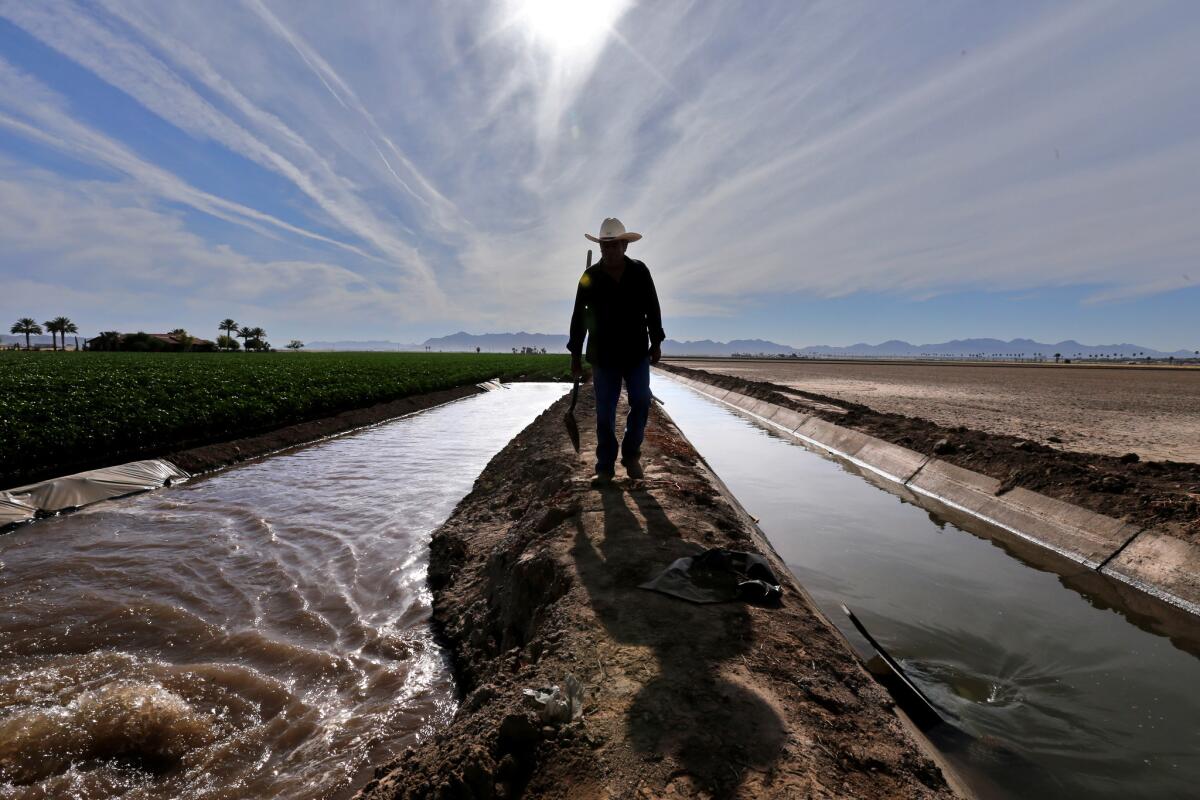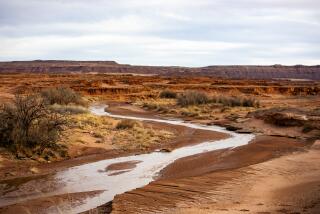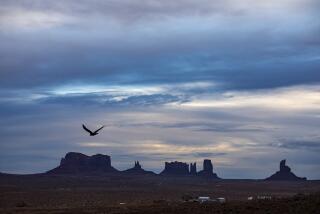Shrinking Colorado River is a growing concern for Yuma farmers — and millions of water users

Reporting from YUMA, Ariz. — The Colorado River begins as snowmelt in the Rocky Mountains and ends 1,450 miles south in Mexico after making a final sacrifice to the United States: water for the farm fields in this powerhouse of American produce.
Throughout the winter, perfect heads of romaine, red-and-green lettuce, spinach and broccoli are whisked from the warm desert soil here onto refrigerated trucks that deliver them to grocery stores across the continent. If you eat a green salad between Thanksgiving and April, whether in Minnesota, Montreal or Modesto, odds are good that some of it was grown in or around Yuma.
For the record:
9:30 p.m. Nov. 16, 2024A map with the print version of this article showed the National Oceanic and Atmospheric Administration’s Colorado River Basin forecast area, not the hydrologic region. Also, the Gulf of California was mislabeled as the Gulf of Mexico. The corrected map is attached to the story.
The summer freshness on all of those winter plates reflects the marvel of engineering the Colorado has become — and why managing the river in the Southwest’s changing landscape seems so daunting.
The Colorado is suffering from a historic drought that has exposed the region’s dependence on a single, vulnerable resource. Nearly 40 million people in seven states depend on the river, a population some forecasts say could nearly double in the next 50 years.
The drought, now in its 16th year, has made one fact brutally clear: The Colorado cannot continue to meet the current urban, agricultural, hydroelectric and recreational demands on it — and the point at which the river will fall short could come sooner than anyone thought.
That is true even after an unusually wet spring in the Rocky Mountains, where runoff feeds the Colorado and its tributaries.
In the decades to come, federal officials say, significant shortages are likely to force water-supply cutbacks in parts of the basin, the first in the more than 90 years that the river has been managed under the 1922 Colorado River Compact.
They would not apply evenly. In Arizona, which would take the steepest cuts, officials are warning that the elaborate conservation measures and infrastructure put in place in the 1980s to guard against shortages will probably not be sufficient. As the drought continues, serious shortages and more severe cutbacks have become more likely.
Farmers who grow cattle feed and cotton in central Arizona could be forced to let fields lie fallow, maybe for good, and cities like Phoenix might have to begin reusing wastewater and even capping urban growth, the region’s economic engine.
Here in Yuma, though, there may be no cuts at all. Thanks to the seemingly endless idiosyncrasies of the rules governing the Colorado, much of metropolitan Phoenix could theoretically become a ghost town while Yuma keeps planting lettuce in the desert.
The looming shortages have opened a contentious new conversation here in Arizona, with increasing calls for rethinking the way the state divides the water it also shares with six other states, including California. Some experts say that a recalibration is in order — that while it may not make sense for millions of people to live in the arid West, people should take precedence over growing leafy greens on an industrial scale.
In a 2013 study, the Bureau of Reclamation suggested transferring about a million acre-feet of water from farms. Academics say it is only a matter of time before agriculture is forced to yield some of its supply — and that farmers could benefit financially from such transfers.
That kind of talk is rattling farmers in Yuma. They know they have water priority but not necessarily political priority.
“They believe there’s a target on their backs,” said Tom Buschatzke, who leads the Arizona Department of Water Resources. “I believe they’re right.”
Farmers here do not intend to go quietly. Some come from families that were here when the big cities of the modern Southwest were little more than crossroads.
“We have a legal right to this,” said Mark Smith, who farms about 500 acres in Yuma and leads one of six irrigation districts in the area. “The guys who say this is an easy fix — it’s not an easy fix. We’re growing vital crops.”
“This is a national debate,” Smith added, “because we’re supplying the entire nation.”
::
Few rivers are asked to work as hard at the Colorado. Ranchers in western Colorado use the river to water pastures for beef cattle, while Denver and its suburbs channel it east across the mountains to enable city living. Las Vegas and other southern Nevada communities draw up to 90% of their water from the Colorado. Hoover Dam and others convert its flow into power. After Arizona and California take their share, the river exits — evaporates, really — through the dry remnants of a delta leading to the Gulf of California.
If a shortage is declared, California is one state that would not face any immediate cutbacks, thanks to an agreement reached with Arizona in 1968. That pact allowed Arizona to build one of the nation’s most ambitious water-supply systems, the Central Arizona Project, but it also ensured that much of Arizona would take steep cuts if a shortage is declared.
Yuma is an exception.
Wedged into a wrinkle of borderland between California and Mexico, farms here have been drawing water from the Colorado since the late 19th century. Their early presence here earned the area the most-senior water rights in Arizona and some of the most-senior in the basin. Of the approximately 15 million acre-feet of water allocated for use each year across the entire basin, about 1 million acre-feet — nearly 7% of all of the water — goes to just 150,000 acres of farmland here.
By comparison, the 5 million water users in Phoenix and Tucson share about 1.5 million acre-feet. California has rights to the largest share, 4.4 million acre-feet, and even under the most dire scenarios it is virtually certain to always receive it. The law of the river says so.
Yet even as parties in the basin are often wary of one another — and not equal partners — most emphasize the need to work together under the current rules. The alternative, some fear, is that the federal government will intervene.
“There are many who have advocated for years that you have to change it significantly,” said Wade Noble, a lawyer for the Yuma County Agricultural Water Coalition. “We, of course, resist that because with our priority we benefit from the [current] law the most.”
In February, Noble helped draft a report by the coalition intended as a preemptive strike against anyone eyeing Yuma water. In it, Yuma leaders argue that the region has become more productive and profitable while also reducing its water use as it has shifted its focus to winter vegetables over the last four decades.
Yet the region still uses an extraordinary amount of water. High soil salinity has led farmers to flood fields in an attempt to wash salt away from fragile roots, then provide more water for irrigation. And in an era seeing the rise of seasonal, locally grown foods, Yuma strikes some as emblematic of old ways of thinking about what people should eat and when.
Then again, farmers in Yuma say cities have been allowed to grow with little concern for the water required to sustain them. They note, too, that most of their crops align with a growing emphasis on healthful eating.
“They are doing a lot of things right,” said Robert Glennon, a law professor at the University of Arizona who specializes in water issues.
But Glennon has also warned that Yuma farmers and others in the arid West may have only so much control over their fate — a lesson farmers in parts of California, dependent on other rivers, are learning during the historic drought there. He has encouraged farmers to reduce production so they can sell or lease a portion of their water rights to cities. Research shows that a cut of just 4% in certain agricultural areas could increase the water supply by 50% for some cities, he said.
Farmers here say the entire region was settled on an ethic of national service. The Bureau of Reclamation began building canals feeding off the Colorado in the first years of the 20th century.
Edward C. Cuming arrived in the summer of 1902, an Irishman who had first migrated to Alberta, Canada, before moving south. Cuming homesteaded 160 acres just south of Yuma, irrigating them with the new canals. The Depression forced him to sell 40 acres but also led to a new era of government support for the area.
The Civilian Conservation Corps, established by President Franklin D. Roosevelt, expanded and improved irrigation canals across the Yuma area. One of those channels, stamped “CCC 1940,” is known as the Cuming Canal. It runs directly in front of fields now owned by Edward Cuming’s grandson, Jim Cuming.
“When we had an abundant supply of water, the farmer was doing a great job,” said Cuming, 77, sitting on a concrete culvert above the Cuming Canal while cloudy Colorado River water surged beneath him.
“Now all of a sudden he’s a villain because he uses too much to produce your fruit and fiber.”
This story was prepared with support from the Society of Environmental Journalists’ Fund for Environmental Journalism.
More to Read
Sign up for Essential California
The most important California stories and recommendations in your inbox every morning.
You may occasionally receive promotional content from the Los Angeles Times.











